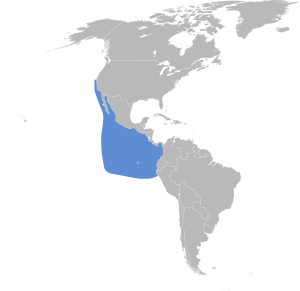Black storm petrel facts for kids
Quick facts for kids Black storm petrel |
|
|---|---|
 |
|
| Conservation status | |
| Scientific classification | |
| Genus: |
Oceanodroma
|
| Species: |
melania
|
 |
|
The black storm petrel (Oceanodroma melania) is a small seabird that belongs to the storm petrel family. It is about 23 centimeters (9 inches) long. Its wings can spread out to 46–51 centimeters (18–20 inches).
Contents
Where They Live and Breed
These birds live in groups called colonies. They breed on islands near the southern California coast in the United States. They also breed off the Baja Peninsula and in the Gulf of California in Mexico.
Nesting Habits
Black storm petrels usually make their nests in cracks in rocks. Sometimes, they use small burrows (holes in the ground) in soft dirt. They might even use old burrows dug by other birds like auklets.
Nighttime Activity
These birds visit their colonies mostly at night. This helps them avoid predators like gulls, hawks, and owls. Like most petrels, they are not very good at walking. They can only shuffle a short distance to their burrow.
Eggs and Chicks
The female black storm petrel lays one white egg each breeding season. If the egg is lost, they rarely lay another one. Both parents take turns sitting on the egg to keep it warm. This is called incubation. It lasts for about 50 days. After the chick hatches, parents keep it warm for a few days. Once the chick can stay warm by itself, both parents go out to find food. Young birds are ready to fly, or fledge, about 10 weeks after hatching.
Life at Sea
Black storm petrels spend the rest of the year out at sea. They tend to stay closer to the shore than other storm petrels. This means you can sometimes spot them from the mainland.
Their Migration Journey
These birds go on a migration away from their breeding areas. What's interesting is that they have two different places where they spend the winter. One area is off Central California in the California Current. The other is further south, along the coast of Central America. This southern wintering area stretches as far as Colombia and Ecuador. Scientists think they migrate this way to avoid strong storms, like hurricanes, in their breeding grounds.
What They Eat
Black storm petrels mainly eat tiny sea creatures called planktonic crustaceans. They especially like the larvae (young forms) of spiny lobsters. They also eat small fish and offal (leftover parts from animals).
How They Find Food
They use several ways to catch their food:
- They can dive up to 1 meter (3 feet) underwater from the air.
- They can feed while swimming on the surface of the water.
- They can also grab food while flying.
When they are out at sea, they usually look for food by themselves.
Conservation Status
The black storm petrel is a common bird. There are several million pairs of them. Because of this, they are not considered an endangered species. However, they have faced problems on some breeding islands. Wild cats and rats have caused losses in some areas. Luckily, Island restoration projects have helped. These projects remove predators from nesting islands, helping the petrels stay safe.
See also
In Spanish: Paíño negro para niños


